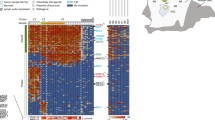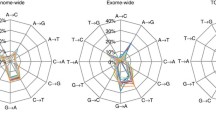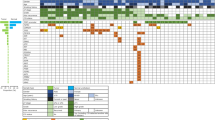Abstract
Although multifocal tumors and non-invasive/invasive components are commonly encountered in surgical pathology, their genetic relationship is often poorly characterized. We used next-generation sequencing (NGS) to characterize somatic alterations in a patient with five spatially distinct, high-grade papillary urothelial carcinomas (UCs), with one tumor harboring an underlying invasive component. NGS of 409 cancer-related genes was performed on DNA isolated from formalin-fixed paraffin-embedded (FFPE) blocks representing each papillary tumor (n = 5), the invasive component of one tumor, and matched normal tissue. We identified nine unique non-synonymous somatic mutations across the six UC samples, including five present in each carcinoma sample, consistent with clonal origin and limited intertumoral heterogeneity. Copy number and loss of heterogeneity (LOH) profiles were similar in all six carcinomas; however, the invasive carcinoma component uniquely showed focal CDKN2A loss and chromosome 9 LOH and did not harbor gains of chromosomes 5p or X that were present in the other tumor samples. Phylogenetic analysis supported the invasive component arising from a shared progenitor prior to the outgrowth of cells in the non-invasive tumors. Results were extended to three additional cases of upper tract UC with paired non-invasive/invasive components, which identified driving alterations exclusive to both non-invasive and invasive components. Lastly, we performed targeted RNA sequencing (RNAseq) using a custom bladder cancer panel, which confirmed gene expression signature differences between paired non-invasive/invasive components. The results and approaches presented here may be useful in understanding the clonal relationships in multifocal cancers or paired non-invasive/invasive components from routine FFPE specimens.






Similar content being viewed by others
References
Babjuk M, Oosterlinck W, Sylvester R et al (2011) EAU guidelines on non-muscle-invasive urothelial carcinoma of the bladder, the 2011 update. Eur Urol 59:997–1008
Xylinas E, Rink M, Margulis V et al (2012) Multifocal carcinoma in situ of the upper tract is associated with high risk of bladder cancer recurrence. Eur Urol 61:1069–1070
Lin HH, Ke HL, Wu WJ, Lee YH, Chang LL (2012) Hypermethylation of E-cadherin, p16, p14, and RASSF1A genes in pathologically normal urothelium predict bladder recurrence of bladder cancer after transurethral resection. Urol Oncol 30:177–181
Bornman DM, Mathew S, Alsruhe J, Herman JG, Gabrielson E (2001) Methylation of the E-cadherin gene in bladder neoplasia and in normal urothelial epithelium from elderly individuals. Am J Pathol 159:831–835
Yamamoto S, Romanenko A, Wei M et al (1999) Specific p53 gene mutations in urinary bladder epithelium after the Chernobyl accident. Cancer Res 59:3606–3609
Denzinger S, Mohren K, Knuechel R et al (2006) Improved clonality analysis of multifocal bladder tumors by combination of histopathologic organ mapping, loss of heterozygosity, fluorescence in situ hybridization, and p53 analyses. Hum Pathol 37:143–151
Louhelainen J, Wijkstrom H, Hemminki K (2000) Allelic losses demonstrate monoclonality of multifocal bladder tumors. Int J Cancer 87:522–527
Simon R, Eltze E, Schafer KL et al (2001) Cytogenetic analysis of multifocal bladder cancer supports a monoclonal origin and intraepithelial spread of tumor cells. Cancer Res 61:355–362
Stoehr R, Knuechel R, Boecker J et al (2002) Histologic-genetic mapping by allele-specific PCR reveals intraurothelial spread of p53 mutant tumor clones. Lab Invest 82:1553–1561
Stoehr R, Hartmann A, Hiendlmeyer E, Murle K, Wieland W, Knuechel R (2000) Oligoclonality of early lesions of the urothelium as determined by microdissection-supported genetic analysis. Pathobiology 68:165–172
Cancer Genome Atlas Research Network (2014) Comprehensive molecular characterization of urothelial bladder carcinoma. Nature 507:315–22
Castillo-Martin M, Domingo-Domenech J, Karni-Schmidt O, Matos T, Cordon-Cardo C (2010) Molecular pathways of urothelial development and bladder tumorigenesis. Urol Oncol 28:401–408
Netto GJ (2012) Molecular biomarkers in urothelial carcinoma of the bladder: are we there yet? Nat Rev Urol 9:41–51
Sidrandsky DF, Frost P, Von Eschenbach A, Oyasu R, Preisinger AC, Vogelstein B (1992) Clonal origin of bladder cancer. N Engl J Med 326:737–740
Gerlinger M, Horswell S, Larkin J et al (2014) Genomic architecture and evolution of clear cell renal cell carcinomas defined by multiregion sequencing. Nat Genet 46:225–23
Gerlinger M, Rowan AJ, Horswell S et al (2012) Intratumor heterogeneity and branched evolution revealed by multiregion sequencing. N Engl J Med 366:883–892
Nordentoft IL P, Birkenkamp-Demtroder K, Shumansky K, Vang S, Hornshoj H, Juul M, Villesen P, Hedegaard J, Roth A, Thorsen K, Hoyer S, Borre M, Reinert T, Fristrup N, Dyrskjot L, Shah S, Pedersen JS, Orntoft TF (2014) Mutational context and diverse clonal developments in early and late bladder cancer. Cell Rep 7:1649–1663
Chang X, Wang K (2012) wANNOVAR: annotating genetic variants for personal genomes via the web. J Med Genet 49:433–436
Wang K, Li M, Hakonarson H (2010) ANNOVAR: functional annotation of genetic variants from high-throughput sequencing data. Nucleic Acids Res 38:3
Grasso C, Butler T, Rhodes K, et al. (2014) Assessing copy number alterations in targeted, amplicon-based next-generation sequencing data. J Mol Diagn. (in press)
Choi W, Porten S, Kim S et al (2014) Identification of distinct basal and luminal subtypes of muscle-invasive bladder cancer with different sensitivities to frontline chemotherapy. Cancer Cell 25:152–165
Damrauer JS, Hoadley KA, Chism DD et al (2014) Intrinsic subtypes of high-grade bladder cancer reflect the hallmarks of breast cancer biology. Proc Natl Acad Sci U S A 111:3110–3115
Balbas-Martinez C, Sagrera A, Carrillo-de-Santa-Pau E et al (2013) Recurrent inactivation of STAG2 in bladder cancer is not associated with aneuploidy. Nat Genet 45:1464–1469
Guo G, Sun X, Chen C et al (2013) Whole-genome and whole-exome sequencing of bladder cancer identifies frequent alterations in genes involved in sister chromatid cohesion and segregation. Nat Genet 45:1459–1463
Iyer G, Al-Ahmadie H, Schultz N et al (2013) Prevalence and co-occurrence of actionable genomic alterations in high-grade bladder cancer. J Clin Oncol 31:3133–3140
Kompier LC, Lurkin I, van der Aa MN, van Rhijn BW, van der Kwast TH, Zwarthoff EC (2010) FGFR3, HRAS, KRAS, NRAS and PIK3CA mutations in bladder cancer and their potential as biomarkers for surveillance and therapy. PLoS One 5:e13821
Rebouissou S, Herault A, Letouze E et al (2012) CDKN2A homozygous deletion is associated with muscle invasion in FGFR3-mutated urothelial bladder carcinoma. J Pathol 227:315–324
Greulich H, Kaplan B, Mertins P et al (2012) Functional analysis of receptor tyrosine kinase mutations in lung cancer identifies oncogenic extracellular domain mutations of ERBB2. Proc Natl Acad Sci U S A 109:14476–14481
Ross JS, Wang K, Gay LM et al (2014) A high frequency of activating extracellular domain ERBB2 (HER2) mutation in micropapillary urothelial carcinoma. Clin Cancer Res 20:68–75
Acknowledgments
The authors thank Mandy Davis and Angela Fullen for technical assistance and Arul Chinnaiyan and Eric Fearon for critical review of the manuscript. This work was supported by the University of Michigan, Department of Anatomic Pathology Operations Committee (to JIW and SAT) and generous gifts from the Teeter and MacLeod families for bladder cancer research at the University of Michigan.
Conflict of interest
SAT has a separate sponsored research agreement with Compendia Bioscience/Life Technologies. None of the study described herein was supported by Compendia Bioscience/Life Technologies, and they had no role in the data collection, interpretation, or analysis and did not participate in the study design or the decision to submit for publication. All authors have no disclosures or conflicts of interest otherwise.
Author information
Authors and Affiliations
Corresponding author
Additional information
Joshua I. Warrick and Daniel H. Hovelson contributed equally to this manuscript.
Electronic supplementary material
Below is the link to the electronic supplementary material.
ESM 1
(PDF 2872 kb)
Rights and permissions
About this article
Cite this article
Warrick, J.I., Hovelson, D.H., Amin, A. et al. Tumor evolution and progression in multifocal and paired non-invasive/invasive urothelial carcinoma. Virchows Arch 466, 297–311 (2015). https://doi.org/10.1007/s00428-014-1699-y
Received:
Revised:
Accepted:
Published:
Issue Date:
DOI: https://doi.org/10.1007/s00428-014-1699-y




